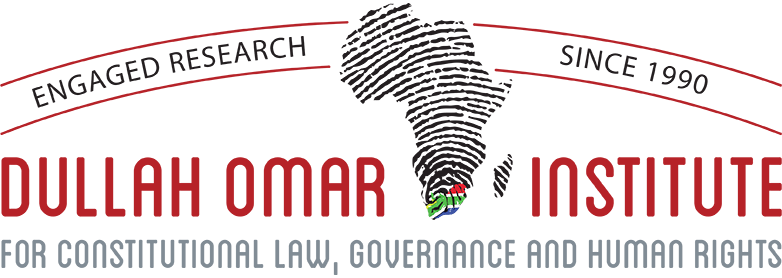Can a provincial government under national intervention intervene in a municipality?
Background
In response to widespread violent protests in the North West Province (NWP) in April 2018, the national executive under President Cyril Ramaphosa delegated an Inter-Ministerial Task Team (IMTT) to assess governance and service delivery in the province. Informed by the IMTT’s Report, the Cabinet invoked section 100(1) of the Constitution and intervened in the NWP. The intervention took effect from 9 May 2018 and, on the same day, the President notified the National Council of Provinces (NCOP) in terms of section 100(2)(a) of the Constitution. A section 100(1) intervention was proclaimed for ten departments in the province, with varying degrees of encroachment. According to the report, five departments were under section 100(1)(a) intervention namely:
- Finance, Economy and Enterprise Development - FEED (Provincial Treasury);
- Rural, Environment and Agriculture Development - READ;
- Social Development;
- Local Government and Human Settlement;
- Tourism.
The other five departments were under section 100(1)(b) intervention namely:
- Health;
- Office of the Premier;
- Education and Sports Development;
- Public Works and Roads;
- Community Safety and Transport Management.
The difference between a section 100(1)(a) intervention and a section 100(1)(b) intervention is significant. A section 100(1)(a) is less intrusive than a section 100(b) intervention. The first entails the issuing of a directive (a command) by the national government to the provincial executive concerned, describing the extent of failure and outlining the required measures or steps to deal with the identified failure. A provincial department which finds itself under section 100(1)(a) intervention, does therefore not ordinarily get ‘stripped of’ its powers by the national government, but retains its executive authority, which it must exercise in line with the content of the directive.
However, the same cannot be said with section 100(1)(b) intervention. This is the most intrusive form of intervention into provinces. It entails a complete assumption of responsibility ‘for the relevant obligation’. So, here the provincial executive that finds itself under section 100(1)(b) intervention get stripped of its executive authority by the national government. This entails ‘intervention’ in the true and literal sense of the word, safe to say that the concerned provincial executive is rendered powerless, and perhaps ‘useless’.
What does the North West High Court judgment entail?
On 18 July 2019, the North West High Court Division in Mafikeng delivered a judgment in the matter between Kagisano Molopo Local Municipality (KMLM) and the Premier of the NWP and others. The Court was asked to determine two contentions. First, whether the provincial executive of the NWP had the necessary authority to intervene in KMLM while it was ‘divested’ by the national government in terms of section 100 of the Constitution. Second, whether, if it had the power to intervene at that time, the exercise of such power was lawful.
On the one hand, the KMLM challenged the decision of the NWP to intervene in terms of section 139(1). It argued that the provincial executive of the NWP had no authority to intervene in the KMLM since the province itself was under section 100(1) intervention of the national government. In other words, in line with their argument, the provincial government was ‘divested’ of its executive powers, including the powers to intervene in local government. This, therefore, the KMLM argued, made the exercise of section 139(1) intervention by NWP unlawful.
The resolution to place the KMLM under section 139(1)(b) of the Constitution was taken on 22 August 2018. It goes without saying that by then the NWP was already under the section 100(1) national intervention, which resumed earlier on 09 May 2018. Inferring from the KMLM’s argument, if the provincial intervention was effected before 09 May 2018, only then it would have been lawful.
On the other hand, the province argued that the provincial executive of the NWP had the authority to invoke section 139(1)(b) intervention in KMLM despite being under section 100(1) intervention of the national government. However, no substantial articulations were made in support of this contention.
Finally, the Court then made an order setting aside the provincial intervention by the NWP in KMLM in terms of section 139(1) of the Constitution. The reasoning of the Court behind the decision was simply to say that the NWP exercised more powers than it actually had at the time.
Is the judgment perhaps a misdirection of law?
It is important to first deal with the relevant provincial executive authority, the DLG&HS, which plays a central role and is responsible for overseeing the operations of local government, including effecting and terminating interventions. As already stated above, the Report of the IMTT suggests that the DLG&HS was under section 100(1)(a), a less intrusive form of intervention, rather than the more intrusive section 100(1)(b). If this is the correct position, this means that the DLG&HS remained with its executive powers (at least in principle), including the power to intervene in terms of section 139(1)(b) of the Constitution. Therefore, the Court’s decision that section 139(1)(b) intervention in the KMLM was unlawful could be incorrect.
The North West High Court held that the ‘invocation of section 100(1) of the Constitution [applied] in respect of the entire Provincial Government of the North West and not a specific department’. It is argued that this position is problematic. The Court was not cautious enough to go a step further in specifying or attaching the form of intervention invoked in respect of each provincial department. The specification of the form of intervention would have been central to the decision of the Court had to make with regard to the legitimacy (or otherwise) of the provincial intervention in KMLM. While one form of intervention would render the provincial executive powerless (s 100(1)(b)), the other would not (s 100(1)(a)).
It is unclear whether the Court took into account the fact that the ‘relevant’ provincial executive authority in the NWP, the DLG&HS, was not ‘divested’ of its powers on 22 August 2018 when the KMLM was put under section 139(1)(b) intervention. In essence, this means the national government supervised the DLG&HS in exercising its powers, and it did not necessarily assume the DLG&HS powers. Based on this, again, the narrative that the provincial intervention in KMLM was foul of the law may be inaccurate.
Conclusion
The judgment of the Court is significant in many ways. The Court dealt with an issue that has not been dealt with before (at least to the writer’s knowledge), which is whether a province under intervention of the national government can intervene in a municipality. Second, the judgement has significant implications on the validity or lack thereof of interventions in more than 14 municipalities in the province which were also under section 139(1) intervention at the time. Do the other interventions automatically fall away? It is submitted that this cannot be the case, meaning that the other interventions would remain valid until they have been withdrawn by the provincial government or set aside by a Court. However, these interventions are now vulnerable to legal challenges.
by Gaopalelwe Lesley Mathiba, LLM Candidate





